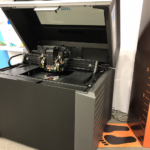

Many are still waiting for the advent of a desktop 3D printer in every home—as ubiquitous as the PC or the kitchen stove—and the common practice of simply fabricating virtually whatever we want due to need or whim before they will believe 3D printing truly has a future. It may be easy to adopt that opinion if you aren’t keeping track of the accelerated pace at which the technology is evolving, and missing out on projections from expert analysts researching areas like that of 3D printed medical devices or investigating what kind of revenues the industry of 3D printing and related technology will produce just in the next year.
Somehow though, it’s all very believable when you hear it from GE—a company that’s certainly not only an inspiration for many others in terms of massive innovation but perhaps a role model too for other industrial heavy hitters as they pave the way for additive manufacturing to progress further around the world, from a smart factory in Chakan, India to their latest $40 million Center for Additive Technology Advancement in Pittsburgh.
Recently, Christine Furstoss, Vice President and Technical Director for Manufacturing and Materials at GE Global Research, presented her thoughts on the much-discussed manufacturing revolution, beginning with explaining how strides in the medical field are indeed enabling the ‘seemingly un-impossible to be possible.’
All it takes is a little digging, and most likely you will agree here—along with so many patients whose lives have been changed—with great strides happening in tumor removals thanks to 3D printed models, as well as the use of 3D printed spinal implants to help patients with degenerative conditions. There are countless other examples at this point in the medical field, as well as other areas like that of aerospace, where GE is a pioneer on many levels. But when it comes to 3D printing, GE, like NASA, has been involved since before you probably knew the technology existed.
GE’s recent testing of their new jet engine—notably, the largest in the world—gave a glimpse into what they are so busy making in these new facilities. Featuring 3D printed fuel nozzles, GE is reaping all the benefits of what the technology has to offer, from self-sustainability in production to incredible opportunity for customization—and of course, increased affordability—much of which is handed to the client as well. As an example, aside from being quite headline-worthy, the 3D printed nozzles offer huge savings from more than just the manufacturing side. What they truly represent is fuel economy:
“Just consider that a one percent improvement in fuel efficiency represents billions of dollars in potential savings to the airline industry,” states Furstoss in her blog. “With 3D printing, we were able to design and print parts that could not be made any other way.”
The supply chain of manufacturing and how it’s being affected is something often discussed within the industry, and Furstoss points out that in order to truly put this disruptive technology to work, industry leaders will have to be invested in the process.
This week, GE has important meetings going on at their Research Center in New York with two dynamic groups within the 3D printing industry today:
- America Makes – recently in the news upon announcing their $10 million project regarding US Air Force sustainment operations, this group stems from the National Additive Manufacturing Institute in Youngstown, Ohio and is also an integral player in the National Network for Manufacturing Innovation (NNMI), established by President Obama.
- The 3MF Consortium, dedicated to setting new standards for 3D printing files, is an industry membership organization that we report on often, and did so earlier in the year as GE Global Research joined.
“When we meet, we’ll be discussing ongoing work but also exploring the keys for additive to take the next big leap from breakthrough moments to full-scale revolution,” says Furstoss. “I believe it really comes down to making technical advances in three key areas: machines, materials and software.”

Furstoss backs up her statement by pointing out that 3D printing is currently seen as ‘reliable,’ evidenced, for example, at the lab in New York where they employ direct metal laser melting (DMLM) 3D printers to produce their fuel nozzles. Several of the machines are found at the facility there, as well as in the Pittsburgh and Auburn facilities. Still, however, the issues at hand are speed and versatility.
“The limitations with production speed and sizes of parts are preventing more widespread use of additive processes,” says Furstoss.
Along with solving the longstanding challenges in speed and range comes further and much needed study of materials science—most especially in metal.
“Today, GE is working with a handful of metal materials in additive processes. In the future, we want to create a database of dozens, even hundreds of new materials. The functionality of materials has always been a big differentiator in product performance, and the use of additive in materials discovery could really exploit that advantage.”
At they explore the use of materials on numerous levels, from that of metal to nanomaterials, the Additive Materials Lab at GE Global Research in New York is working on what Furstoss refers to as the recipe book on 3D and additive materials.
While Furstoss discusses software last, it’s certainly an integral part of the 3D printing ecosystem—after all, even from the desktop, what’s one of the first things you have to set up, learn, and then use in order to produce a 3D print? On the industrial level this is obviously much more complex and necessary, and allows for much greater communication. GE has, like many other businesses of all sizes, turned to both the cloud and crowdsourcing platforms as they work to ‘accelerate knowledge’ and innovate with more progressive designs—faster.
“The availability of these platforms through forums such as those sponsored by GrabCAD, NineSigma and others have really opened up who can participate in design and product development and the number of good ideas that can be seen and reviewed,” says Furstoss.
She states that until companies like GE can print ‘on-demand’ like paper—there is still an enormous amount of work to be done and progress to be made. As issues regarding machinery, materials, and software are being solved, a critical factor will be how additive stakeholders allow for more cohesion.
“This is perhaps the most critical factor in determining how transformative additive could be. We need to develop and grow the ecosystem to truly move additive from these breakout moments to a full-scale revolution,” says Furstoss.
The future of 3D printing and the challenges that lie ahead is a popular topic. What are your thoughts on this? Discuss further in the Furstoss Discusses 3D Printing Future over at 3DPB.com.
[Source / Images: GE Reports]
If you're looking to get architectural 3D animation in the USA, our service provides an exceptional way to bring your architectural concepts to life through dynamic, immersive visuals. Through our platform, you can easily request high-quality 3D animations that showcase your designs in motion, offering a detailed view of your project from multiple angles and perspectives. Whether it's for a real estate development, a commercial building, or an urban planning project, our expert team ensures that every detail is captured in a visually compelling animation.
Through our website, you can seamlessly get architectural 3D animation tailored to your project’s specific needs. With our help, you can offer potential clients or investors an engaging experience that goes beyond static images. By integrating CGI animations with real-world settings, lighting, and textures, our team creates a lifelike experience that allows your audience to interact with your project as though it were already built. This service is perfect for presenting complex designs in a clear, visually attractive way that stands out in the competitive architectural market.




